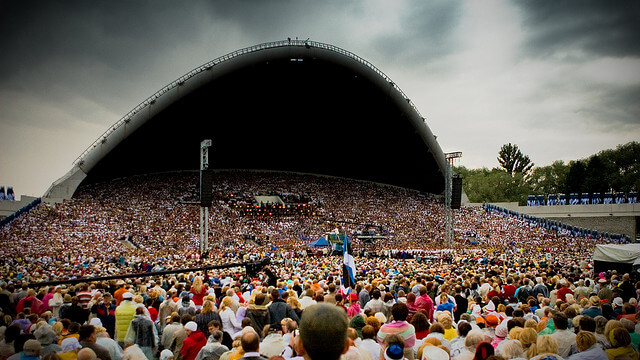The Singing Revolution
You say you want a revolution
Well, you know
We all want to change the world.
The Estonian Philharmonic Chamber Choir, which performs at Purdue on November 20, represents a proud tradition that really did change the world—the Singing Revolution was a major force in Estonia’s independence movement.
Choral music has long played an important role in Estonian culture, and Laulupidu, the Estonian Song Festival, is the apex of that choral culture. Now held every five years in Tallinn, Estonia’s capital, Laulupidu regularly features approximately 25,000 amateur singers, with up to 18,000 performing simultaneously. In 2009, over 200,000 people attended the festival, which also features traditional Estonian dance.
The first nationwide song festival in 1869 was held in Tartu and organized by Johann Voldemar Jannsen, a journalist, poet, and choral society leader. His daughter, the poet Lydia Koidula, wrote the poem “Mu isamaa on minu arm” (“Land of my Fathers, Land that I Love”), and it was set to music for the festival by Aleksander Kunileid. Though Estonia was part of the Russian Empire at that time, a growing national consciousness, or “Great Awakening” was gripping Estonians, and the choral festival with its patriotic songs became a popular symbol of this nationalist sentiment. The Republic of Estonia was declared in 1918, and though it was occupied by the Germans for a short time, the end of World War I forced a German retreat from Estonia in November of that year.
But World War II soon followed, and in 1939, Hitler and Stalin signed the Molotov-Ribbentrop Pact, secretly dividing Europe between them. Stalin threatened to invade and occupy Estonia, along with Latvia and Lithuania, if these nations didn’t allow him to establish Soviet military bases. Seeing Poland’s fate, and promised it could maintain its independence, Estonia agreed. Stalin wasn’t big on keeping promises, though, and by 1940, the occupation of all three nations was complete, with former government leaders killed or deported. Estonia changed hands between Russia and Germany during the course of the war, but by 1944, Russian power was firmly established again, and Estonia’s independent republic was over.
Song continued to play an important role in national identity, and at the 1947 Laulupidu, “Mu isamaa on minu arm” was set to new music by Gustav Ernesaks and performed for the first time under Stalinist rule, as a sign of defiance and hope. It didn’t take long for Soviet censors to realize the power of such songs to bolster Estonian national identity, and they were banned from the program.
Estonians continued to sing them whenever possible, however, and at the 100th anniversary of Laulupidu, Estonians sang “Mu isamaa on minu arm“ as a challenge to the Soviets. When ordered to leave the stage, the choir sang it a second time, joined by the audience, while a Soviet orchestra played to drown out the song. The orchestra simply couldn’t match the power of so many voices, so to save face, the Soviets invited the conductor back to the stage to perform the song again, as if they had planned the encore themselves.
Fast forward to 1985, when Gorbachev introduced glasnost, the policy of loosening restrictions on speech and information in the Soviet Union. Emboldened, Estonians began to test the limits of this openness, protesting over environmental issues and the illegality of the Molotov-Ribbentrop Pact. Song played a huge role in these protests. In 1988, a pop festival in Tartu featured several new nationalist rock anthems, and after another rock festival was halted by the Soviets in Tallinn, thousands walked to the festival grounds for a spontaneous singing event, which continued with over 100,000 participants each evening for the rest of the week. Estonians began to display their old (illegal) flag again, and in September of 1988, over 300,000 people (almost a quarter of all Estonians!) took part in a protest and song festival at the same grounds where Laulupidu is held, demanding independence.
Nonviolent action continued in 1989, as Estonians, Latvians, and Lithuanians formed a 370-mile human chain running the length of their nations, holding hands and singing to protest the 50th anniversary of the Molotov-Ribbentrop Pact. In 1991, all three nations declared independence, and in each case, protesters formed human chains around television and radio towers to prevent their takeover by Soviet forces, facing down tanks and singing for their freedom. A 2006 documentary on the Singing Revolution shares many more details on the history of Estonia’s music and its role in the nation’s fight for independence. (You can also check out the International Center for Nonviolent Conflict or the Global Nonviolent Action Database for more on the Singing Revolution.)
The Estonian Philharmonic Chamber Choir will sing part of this national tradition at Purdue, including Mart Saar’s national epic, “Seven Moss-Grown Beds,” describing Estonia’s history of war and occupation and Cyrillus Kreek’s “Singer’s Kinsfolk,” where song is the singer’s spouse in the holy fatherland. The group will also share St John’s Day Songs for midsummer’s eve by Veljo Tormis. The choir has a special relationship with well-known Estonian composer Arvo Pärt, and will sing five of his compositions as well.
Lennon wasn’t so sure about some of the revolutionary tactics he saw in 1968 when The Beatles released “Revolution.” The Singing Revolution, however, reminds us just how powerful art can be in shaping our identities, bringing us hope, and defying totalitarianism.
Stacey Mickelbart, guest contributor
